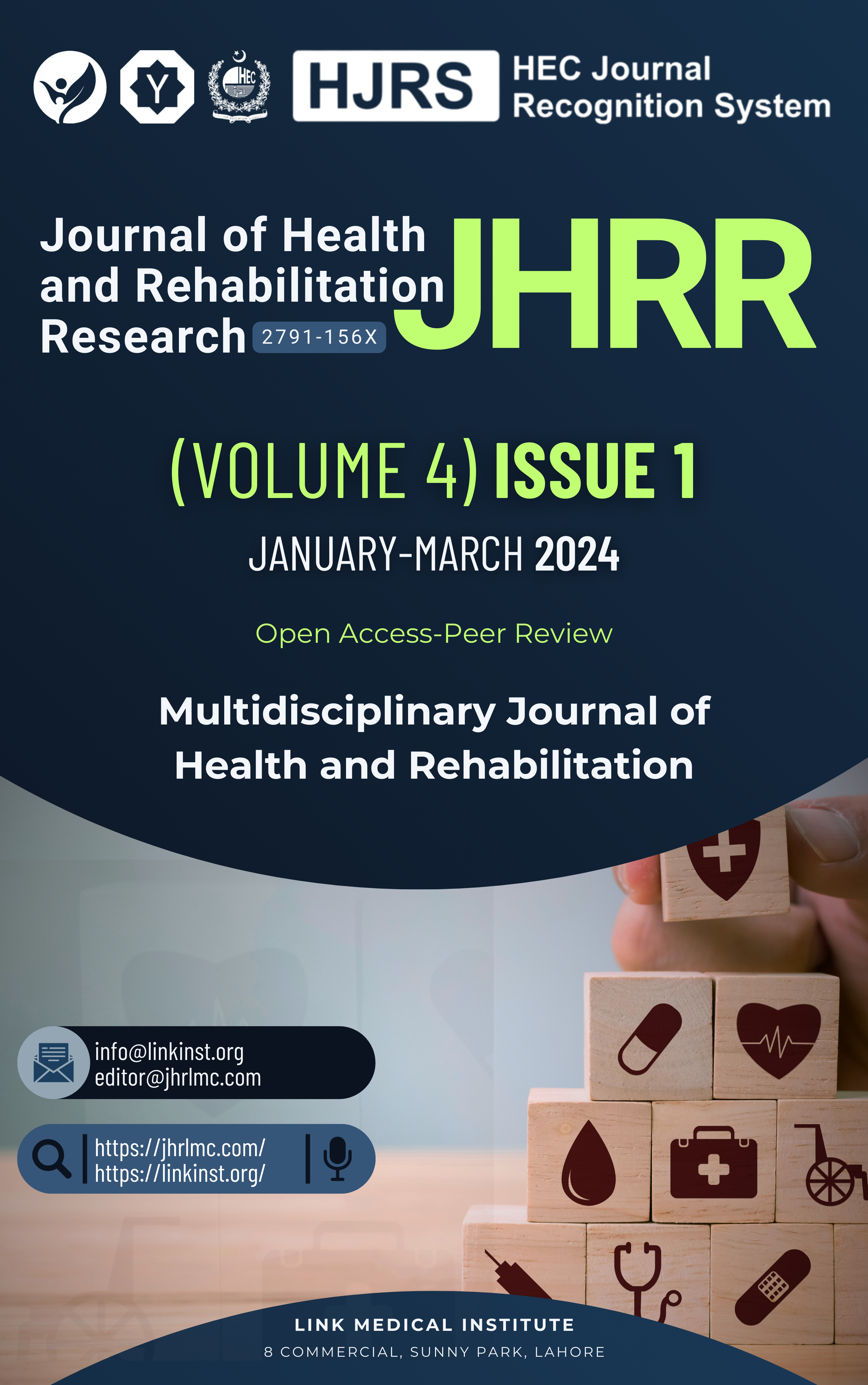Serum Ferritin Level and Total Iron Binding Capacity Relationship with Iron Deficiency Anemia During Pregnancy and Labour
DOI:
https://doi.org/10.61919/jhrr.v4i1.622Keywords:
Iron Deficiency Anemia, Pregnancy, Maternal Health, Feto-Maternal Complications, Serum Ferritin, Total Iron-Binding Capacity, Antenatal Care, Neonatal OutcomesAbstract
Background: Iron deficiency anemia (IDA) is a prevalent condition globally, impacting maternal and fetal health outcomes significantly. The condition is especially concerning during pregnancy, given its association with complications such as preterm labor and increased maternal and neonatal morbidity and mortality rates.
Objective: The study aimed to assess the prevalence of IDA among pregnant women and its correlation with fetal-maternal complications, as well as to evaluate the effectiveness of current healthcare interventions in managing the condition.
Methods: A cross-sectional study was conducted at Shikhzayad Women Hospital, Larkana, over six months from January 1, 2022, to July 1, 2022. Fifty pregnant women with IDA at various gestational stages were selected and evaluated for serum ferritin and total iron-binding capacity (TIBC). The severity of anemia and its correlation with feto-maternal complications were analyzed using SPSS version 25.
Results: Out of the 50 women studied, 6 had mild anemia, 37 had moderate anemia, and 7 had severe anemia. Serum ferritin levels showed that 10 participants had levels between 5-10 mg/L, 20 had levels between 10-50 mg/L, 10 had levels between 50-150 mg/L, and 10 had normal levels (150-300 mg/L). Elevated TIBC levels (400-600 ug/ml) were observed in 30 women. Feto-maternal complications included emergency cesarean sections (28 cases), postpartum hemorrhage (8 cases), disseminated intravascular coagulation (6 cases), cardiac failure (4 cases), and maternal death (4 cases). Pregnancy outcomes were reported as 5 first-trimester abortions, 2 second-trimester abortions, 4 preterm deliveries, 15 cases of intrauterine growth restriction (IUGR), 9 intrauterine deaths (IUD), and 5 neonatal deaths (NND).
Conclusion: IDA remains a significant determinant of adverse maternal and neonatal outcomes. This study underscores the urgent need for enhanced preventive strategies, including iron supplementation and dietary education. Further large-scale research is required for a comprehensive understanding of IDA's impact and the development of targeted interventions.
Downloads
References
Chang M-L, Hu J-H, Yen C-H, Chen K-H, Kuo C-J, Lin M-S, et al. Evolution of ferritin levels in hepatitis C patients treated with antivirals. Scientific reports. 2020;10(1):19744.
Chen Y, Wan J, Xia H, Li Y, Xu Y, Lin H, et al. Total iron binding capacity (TIBC) is a potential biomarker of left ventricular remodelling for patients with iron deficiency anaemia. BMC cardiovascular disorders. 2020;20:1-9.
DePalma RG, Hayes VW, O'Leary TJ. Optimal serum ferritin level range: Iron status measure and inflammatory biomarker. Metallomics. 2021;13(6):mfab030.
Faruqi A, Mukkamalla SKR. Iron binding capacity. 2020.
Freeman HJ. Iron deficiency anemia in celiac disease. World Journal of Gastroenterology: WJG. 2015;21(31):9233.
Galetti V, Stoffel NU, Sieber C, Zeder C, Moretti D, Zimmermann MB. Threshold ferritin and hepcidin concentrations indicating early iron deficiency in young women based on upregulation of iron absorption. EClinicalMedicine. 2021;39.
Grant ES, Clucas DB, McColl G, Hall LT, Simpson DA. Re-examining ferritin-bound iron: current and developing clinical tools. Clinical Chemistry and Laboratory Medicine (CCLM). 2021;59(3):459-71.
Hasan HR, Kadhum ZIA, Ghadhban JM. Biochemical Markers of Iron Status Among Iraqi Patients at Different Severity Levels of Celiac Disease. Iraqi Journal of Science. 2024.
Ikeda-Taniguchi M, Takahashi K, Shishido K, Honda H. Total iron binding capacity is a predictor for muscle loss in maintenance hemodialysis patients. Clinical and Experimental Nephrology. 2022;26(6):583-92.
Jimenez K, Kulnigg-Dabsch S, Gasche C. Management of iron deficiency anemia. Gastroenterology & hepatology. 2015;11(4):241.
Kishore G, Ejaz M, Kumar J, Lal A, Tahir H, Anjum Z, et al. Association between Helicobacter pylori infection and serum iron profile. Cureus. 2021;13(9).
Lu M, Liu Y, Shao M, Tesfaye GC, Yang S. Associations of iron intake, serum iron and serum ferritin with bone mineral density in women: the National Health and Nutrition Examination Survey, 2005–2010. Calcified Tissue International. 2020;106:232-8.
Means RT. Iron deficiency and iron deficiency anemia: implications and impact in pregnancy, fetal development, and early childhood parameters. Nutrients. 2020;12(2):447.
Miller JL. Iron deficiency anemia: a common and curable disease. Cold Spring Harbor perspectives in medicine. 2013;3(7):a011866.
Organization WH. WHO guideline on use of ferritin concentrations to assess iron status in populations: World Health Organization; 2020.
Pavord S, Myers B, Robinson S, Allard S, Strong J, Oppenheimer C, et al. UK guidelines on the management of iron deficiency in pregnancy. British journal of haematology. 2012;156(5):588-600.
Rahat A, Kamani L. Frequency of iron deficiency anemia (IDA) among patients with Helicobacter pylori infection. Pakistan Journal of Medical Sciences. 2021;37(3):776.
Ribot-Hernández I, Martín-González C, Vera-Delgado V, González-Navarrete L, de Armas-González JF, Viña-Rodríguez J, et al. Prognostic value of serum iron, ferritin, and transferrin in chronic alcoholic liver disease. Biological trace element research. 2020;195:427-35.
Sab PC, Kaur G, Kaur P, Tahlan A, Bedi RK, Mittal K, et al. Assessment of serum iron stores in regular plateletpheresis donors. Transfusion and Apheresis Science. 2022;61(1):103291.
Sifakis S, Pharmakides G. Anemia in pregnancy. Annals of the New York Academy of Sciences. 2000;900(1):125-36.
Tandon R, Jain A, Malhotra P. Management of iron deficiency anemia in pregnancy in India. Indian Journal of Hematology and Blood Transfusion. 2018;34:204-15.
Wang Y, Yang Z, Wu J, Xie D, Yang T, Li H, et al. Associations of serum iron and ferritin with hyperuricemia and serum uric acid. Clinical Rheumatology. 2020;39:3777-85.
Downloads
Published
How to Cite
Issue
Section
License
Copyright (c) 2024 Majida Ali, Ishfaque Ahmed Mugheri, Noshaba Nafees Abro, Saeed Un Nisa Sangi, Afshan Tariq Bhatti, Shazia Shiakh

This work is licensed under a Creative Commons Attribution 4.0 International License.
Public Licensing Terms
This work is licensed under the Creative Commons Attribution 4.0 International License (CC BY 4.0). Under this license:
- You are free to share (copy and redistribute the material in any medium or format) and adapt (remix, transform, and build upon the material) for any purpose, including commercial use.
- Attribution must be given to the original author(s) and source in a manner that is reasonable and does not imply endorsement.
- No additional restrictions may be applied that conflict with the terms of this license.
For more details, visit: https://creativecommons.org/licenses/by/4.0/.






